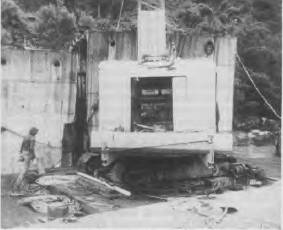- Author
- Lind, L.J.
- Subjects
- History - general
- Tags
-
- RAN Ships
- None noted.
- Publication
- December 1990 edition of the Naval Historical Review (all rights reserved)
Len was a man of many skills and later in 1973 at the first exhibition held by the Society, Navy Day, he staged a programme of duels which were fought in full armour using swords, daggers and iron studded maces.
A transcript of his lecture, ‘The American Civil War’, sold more than 500 copies.
Two talented members were responsible at this period of increasing our sales. They were Kevin Brown and Paul Webb. Kevin produced photographs of 114 ships of the RAN and Paul, a Victorian member, 52 plans of Australian and British warships. The photographs sold at 30 cents each and the plans for $1.10.
In 1971 we rented Post Office Box 3 at Garden Island Post Office and this has remained the Society’s official address over twenty years. The post box was 6 inches square and 12 inches deep which soon proved inadequate to hold our mail. By 1973 it had been supplemented by a butter box on the floor.
Progress with HMAS Parramatta
My negotiations with the Parramatta City Council bore fruit in April. A public meeting held in the City Council Chambers, chaired by the Mayor, was attended by more than 200 people. I addressed the audience for 20 minutes on why two sections of HMAS PARRAMATTA should be salvaged and preserved as memorials and the Mayor supported the proposal. A motion to this effect was carried unanimously.
To finance the project a public appeal was launched and given wide publicity in the media. In three months a little over $5,000 was raised.
Tenders for the salvage project were let in June and a contract was signed with Sydney Bridge and Wharf Ltd. The tenderer undertook to cut free the bow and stern sections of the old destroyer and to transport the sections by sea to Rydalmere and then by road to Parramatta. The price was $3,750.
The salvage operation which commenced in July was the most interesting in which I have been involved. A team consisting of Commander George Knox, Lieutenant Peter Churchill and myself marked the cut lines for the contractor. Some guesswork was involved as it was difficult to estimate the weight of the respective sections which the contractor insisted should not exceed 20 tons. We were lucky – the bow weighed 18.5 tons and the stern with its unique but heavy outboard rudder, some 25.9 tons. The contractor accepted our chalk lines.
Severing the two sections from the hull was carried out during the week. It is doubtful whether the operation would have been undertaken today with safety rules which have been introduced since. The Swedish steel plates of PARRAMATTA had been cold dipped galvanised and when subjected to the intense heat of an oxy-acetylene burner gave off highly toxic fumes. This did not deter Sydney Wharf and Bridge.
Lifting the two sections of the ship was delayed until Saturday morning to enable us to obtain the maximum media coverage. At 8 am the normally deserted bay was surrounded by a flotilla of spectator craft, three media helicopters buzzed overhead and a large number of spectators were gathered on the shore.
High tide on that morning was 10 am and it was necessary that the complete operation should be completed between 9 am and 11 am. At high tide there was two foot of water and three foot of glutinous mud alongside PARRAMATTA. The crane barge had a draft of five feet and during the lift would be hard aground. To overcome this problem and to manoeuvre the barge into position it was necessary to rig heavy hawsers and secure them to trees ashore and run others to heavy sinkers laid on the seabed offshore.

At 9 am sharp the barge’s winch took the strain on the shore hawser and slowly the barge slid across the mud into the lifting position. The transport barge was then positioned outward of the crane barge. The first lift, the bow section, was carried out with minimal difficulty. To the uninitiated it was like a dentist drawing a tooth. The keel was deeply embedded in the mud and the crane boom was swung from side until the suction grip was broken. When it rose above the surface a cheer rung out from the goofers.




